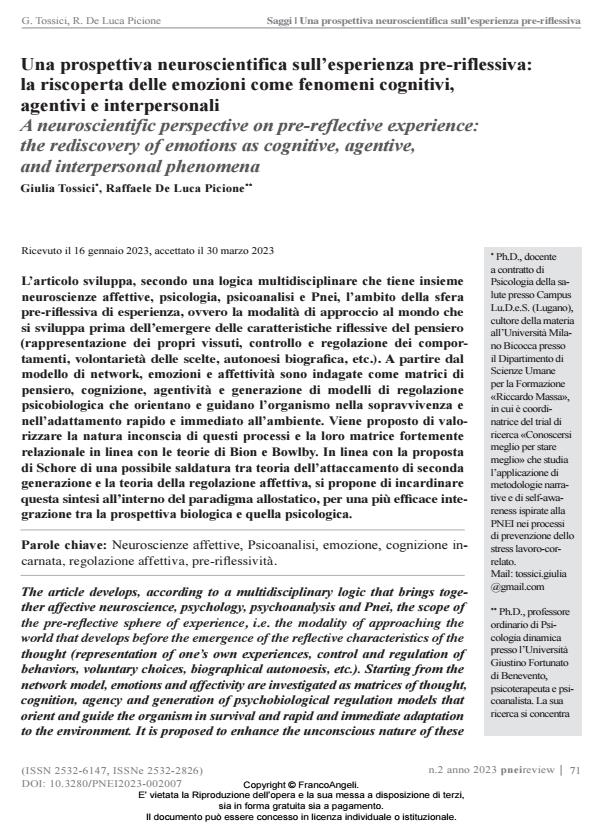A neuroscientific perspective on pre-reflective experience: the rediscovery of emotions as cognitive, agentive, and interpersonal phenomena
Journal title PNEI REVIEW
Author/s Giulia Tossici, Raffaele De Luca Picione
Publishing Year 2023 Issue 2023/2
Language Italian Pages 18 P. 71-88 File size 1154 KB
DOI 10.3280/PNEI2023-002007
DOI is like a bar code for intellectual property: to have more infomation
click here
Below, you can see the article first page
If you want to buy this article in PDF format, you can do it, following the instructions to buy download credits

FrancoAngeli is member of Publishers International Linking Association, Inc (PILA), a not-for-profit association which run the CrossRef service enabling links to and from online scholarly content.
The article develops, according to a multidisciplinary logic that brings toge- ther affective neuroscience, psychology, psychoanalysis and Pnei, the scope of the pre-reflective sphere of experience, i.e. the modality of approaching the world that develops before the emergence of the reflective characteristics of the thought (representation of one’s own experiences, control and regulation of behaviors, voluntary choices, biographical autonoesis, etc.). Starting from the network model, emotions and affectivity are investigated as matrices of thought, cognition, agency and generation of psychobiological regulation models that orient and guide the organism in survival and rapid and immediate adaptation to the environment. It is proposed to enhance the unconscious nature of these processes and their deeply relational matrix in line with the theories of Bion and Bowlby. In line with Schore’s proposal of a possible welding between se- cond generation attachment theory and affect regulation theory, it is proposed to hinge this synthesis within the allostatic paradigm, for a more effective inte- gration between the biological perspective and the psychological one.
Keywords: Affective neuroscience, Psychoanalysis, emotion, embodied cognition, affective regulation, pre-reflexivity.
-
The aesthetic and affective matrix of pre-reflective sensemaking at the origins of the relationship between subject and world: A dialogue between Kant’s
Third Critique
and psychoanalysis
Giulia Tossici, Raffaele De Luca Picione, in The International Journal of Psychoanalysis /2024 pp.169
DOI: 10.1080/00207578.2024.2306937
Giulia Tossici, Raffaele De Luca Picione, Una prospettiva neuroscientifica sull’esperienza pre-riflessiva: la riscoperta delle emozioni come fenomeni cognitivi, agentivi e interpersonali in "PNEI REVIEW" 2/2023, pp 71-88, DOI: 10.3280/PNEI2023-002007